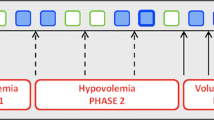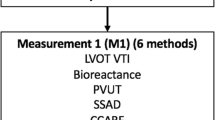Abstract
Purpose
To validate a novel method of ultrasound dilution (COstatus®; Transonic Systems, Ithaca, NY) for measuring cardiac output in paediatric patients after biventricular repair of congenital heart disease.
Methods
Children undergoing biventricular repair of congenital heart disease were prospectively identified. Patients with significant intracardiac shunts were excluded. Postoperative cardiac output was measured by ultrasound dilution (COud) and concurrently calculated by the Fick equation (COrms) using measured oxygen consumption by respiratory mass spectrometry.
Results
Thirty-five patients were studied generating 66 individual data sets. Subjects had a median (interquartile range) age of 147 days (11, 216), weight of 4.98 kg (3.78, 6.90) and body surface area of 0.28 m2 (0.22, 0.34). Of the patients, 66 % had peripheral arterial catheters and 34 % had femoral cannulation; peripheral arterial lines accounted for 6/8 of unsuccessful studies due to inability to generate sufficient flow. The site of the central venous cannula did not impact the feasibility of completing the study. A mean bias of 0.00 L/min [2 standard deviation (SD) ± 0.76 L/min] between COud and COrms was found with a percentage error of 97 %. When comparing cardiac index, bias increased to 0.13 L/min/m2 (2SD ± 2.16 L/min/m2).
Conclusions
Cardiac output by ultrasound dilution showed low bias with wide limits of agreement when compared to measurement derived by the Fick equation. Although measurements through central and peripheral arterial lines were completed with minimal difficulties in the majority of patients, the application of COstatus® in neonates with low body surface area may be limited.



Similar content being viewed by others
References
Wernovsky G, Wypij D, Jonas RA, Mayer JE Jr, Hanley FL, Hickey PR, Walsh AZ, Chang AC, Castaneda AR, Newburger JW et al (1995) Postoperative course and hemodynamic profile after the arterial switch operation in neonates and infants. A comparison of low-flow cardiopulmonary bypass and circulatory arrest. Circulation 92:2226–2235
Boyd AD, Tremblay RE, Spencer FC, Bahnson HT (1959) Estimation of cardiac output soon after intracardiac surgery with cardiopulmonary bypass. Ann Surg 150:613–626
Linton RA, Jonas MM, Tibby SM, Murdoch IA, O’Brien TK, Linton NW, Band DM (2000) Cardiac output measured by lithium dilution and transpulmonary thermodilution in patients in a paediatric intensive care unit. Intensive Care Med 26:1507–1511
Fakler U, Pauli C, Balling G, Lorenz HP, Eicken A, Hennig M, Hess J (2007) Cardiac index monitoring by pulse contour analysis and thermodilution after pediatric cardiac surgery. J Thorac Cardiovasc Surg 133:224–228
Crittendon I 3rd, Dreyer WJ, Decker JA, Kim JJ (2012) Ultrasound dilution: an accurate means of determining cardiac output in children*. Pediatr Crit Care Med 13:42–46
Darling E, Thuramalla N, Searles B (2011) Validation of cardiac output measurement by ultrasound dilution technique with pulmonary artery thermodilution in a pediatric animal model. Pediatr Cardiol 32:585–589
Eremenko AA, Safarov PN (2010) Flow-regulated extracorporeal arteriovenous tubing loop for cardiac output measurements by ultrasound velocity dilution: validation in post-cardiac surgery intensive care unit patients. ASAIO J 56:522–526
Gaies MG, Gurney JG, Yen AH, Napoli ML, Gajarski RJ, Ohye RG, Charpie JR, Hirsch JC (2010) Vasoactive-inotropic score as a predictor of morbidity and mortality in infants after cardiopulmonary bypass. Pediatr Crit Care Med 11:234–238
Shekerdemian LS, Shore DF, Lincoln C, Bush A, Redington AN (1996) Negative-pressure ventilation improves cardiac output after right heart surgery. Circulation 94:II49–II55
Davies NJ, Denison DM (1979) The measurement of metabolic gas exchange and minute volume by mass spectrometry alone. Respir Physiol 36:261–267
Richard C, Warszawski J, Anguel N, Deye N, Combes A, Barnoud D, Boulain T, Lefort Y, Fartoukh M, Baud F, Boyer A, Brochard L, Teboul JL (2003) Early use of the pulmonary artery catheter and outcomes in patients with shock and acute respiratory distress syndrome: a randomized controlled trial. JAMA 290:2713–2720
Harvey S, Harrison DA, Singer M, Ashcroft J, Jones CM, Elbourne D, Brampton W, Williams D, Young D, Rowan K (2005) Assessment of the clinical effectiveness of pulmonary artery catheters in management of patients in intensive care (PAC-Man): a randomised controlled trial. Lancet 366:472–477
Shah MR, Hasselblad V, Stevenson LW, Binanay C, O’Connor CM, Sopko G, Califf RM (2005) Impact of the pulmonary artery catheter in critically ill patients: meta-analysis of randomized clinical trials. JAMA 294:1664–1670
Connors AF Jr, Speroff T, Dawson NV, Thomas C, Harrell FE Jr, Wagner D, Desbiens N, Goldman L, Wu AW, Califf RM, Fulkerson WJ Jr, Vidaillet H, Broste S, Bellamy P, Lynn J, Knaus WA (1996) The effectiveness of right heart catheterization in the initial care of critically ill patients. SUPPORT Investigators. JAMA 276:889–897
Sandham JD, Hull RD, Brant RF, Knox L, Pineo GF, Doig CJ, Laporta DP, Viner S, Passerini L, Devitt H, Kirby A, Jacka M (2003) A randomized, controlled trial of the use of pulmonary-artery catheters in high-risk surgical patients. N Engl J Med 348:5–14
Wiener RS, Welch HG (2007) Trends in the use of the pulmonary artery catheter in the United States, 1993–2004. JAMA 298:423–429
Tibby SM, Hatherill M, Marsh MJ, Murdoch IA (1997) Clinicians’ abilities to estimate cardiac index in ventilated children and infants. Arch Dis Child 77:516–518
Eisenberg PR, Jaffe AS, Schuster DP (1984) Clinical evaluation compared to pulmonary artery catheterization in the hemodynamic assessment of critically ill patients. Crit Care Med 12:549–553
Galstyan G, Bychinin M, Alexanyan M, Gorodetsky V (2010) Comparison of cardiac output and blood volumes in intrathoracic compartments measured by ultrasound dilution and transpulmonary thermodilution methods. Intensive Care Med 36:2140–2144
Li J, Bush A, Schulze-Neick I, Penny DJ, Redington AN, Shekerdemian LS (2003) Measured versus estimated oxygen consumption in ventilated patients with congenital heart disease: the validity of predictive equations. Crit Care Med 31:1235–1240
Li J, Zhang G, Holtby HM, McCrindle BW, Cai S, Humpl T, Caldarone CA, Williams WG, Redington AN, Van Arsdell GS (2006) Inclusion of oxygen consumption improves the accuracy of arterial and venous oxygen saturation interpretation after the Norwood procedure. J Thorac Cardiovasc Surg 131:1099–1107
Critchley LA, Critchley JA (1999) A meta-analysis of studies using bias and precision statistics to compare cardiac output measurement techniques. J Clin Monit Comput 15:85–91
Light RB (1988) Intrapulmonary oxygen consumption in experimental pneumococcal pneumonia. J Appl Physiol 64:2490–2495
Axler O, Tousignant C, Thompson CR, Dall’ava-Santucci J, Phang PT, Russell JA, Walley KR (1996) Comparison of transesophageal echocardiographic, Fick, and thermodilution cardiac output in critically ill patients. J Crit Care 11:109–116
Sherman MS, Kosinski R, Paz HL, Campbell D (1997) Measuring cardiac output in critically Ill patients: disagreement between thermodilution-, calculated-, expired gas-, and oxygen consumption-based methods. Cardiology 88:19–25
Gonzalez J, Delafosse C, Fartoukh M, Capderou A, Straus C, Zelter M, Derenne JP, Similowski T (2003) Comparison of bedside measurement of cardiac output with the thermodilution method and the Fick method in mechanically ventilated patients. Crit Care 7:171–178
Scheinman MM, Brown MA, Rapaport E (1969) Critical assessment of use of central venous oxygen saturation as a mirror of mixed venous oxygen in severely ill cardiac patients. Circulation 40:165–172
Tsutsui M, Matsuoka N, Ikeda T, Sanjo Y, Kazama T (2009) Comparison of a new cardiac output ultrasound dilution method with thermodilution technique in adult patients under general anesthesia. J Cardiothorac Vasc Anesth 23:835–840
Acknowledgements
We would like to acknowledge Transonic Systems (Ithaca, NY) supplying the COstatus® equipment and study disposables.
Author information
Authors and Affiliations
Corresponding author
Rights and permissions
About this article
Cite this article
Floh, A.A., La Rotta, G., Wermelt, J.Z. et al. Validation of a new method based on ultrasound velocity dilution to measure cardiac output in paediatric patients. Intensive Care Med 39, 926–933 (2013). https://doi.org/10.1007/s00134-013-2848-5
Received:
Accepted:
Published:
Issue Date:
DOI: https://doi.org/10.1007/s00134-013-2848-5




